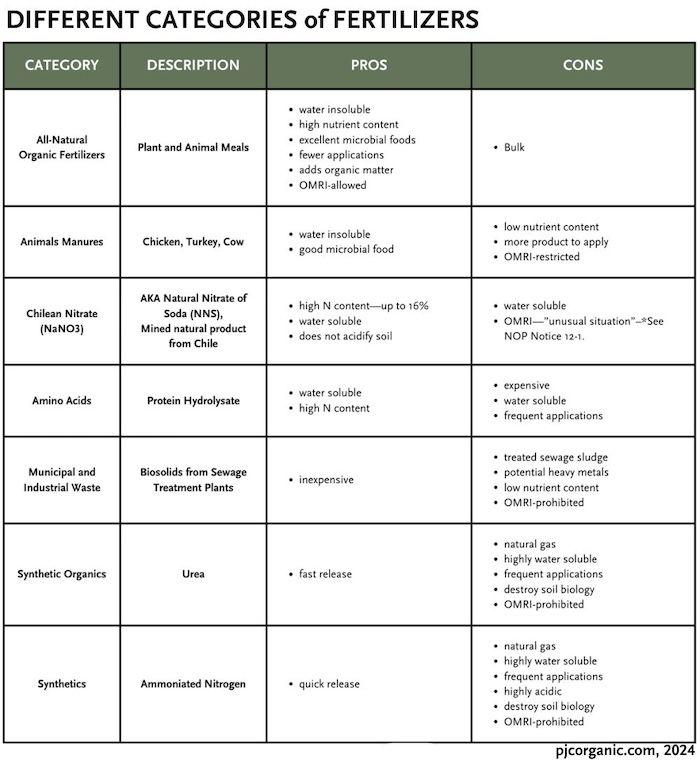Many products are marketed as organic, but consumers rarely know the differences behind the bag. Certain fertilizers lend themselves better to an All-Natural Organic Turf Care (OTC) approach and some work against it. Fertilizers fall into several categories, each with associated pros and cons. We list the differences between organic fertilizers in the chart, and go into greater depth below.

1. All-Natural Organic Fertilizers
All-Natural Organic Fertilizers (like PJC’s ProHealthy Turf Blends) get their nutrient content from plant and animal meals. Plant and animal meals are high nitrogen sources. The cost-per-nutrient tends to be less than other organic alternatives due to all-natural organic fertilizer’s high nutrient content. They have been found to be excellent fungal and bacterial foods, which are critical in an all-natural program. Although the bulk associated with natural organic fertilizers is often seen as a disadvantage, the advantage is that organic matter and valuable nutrients are added to the soil.
2. Animal Manures
Animal manures are a common form of organic fertilizer. There is often a low cost-per-pound because the base is a waste product. Although, there’s also a lower nutrient content, so the cost-per-nutrient tends to be high. To reach a target nutrient value, you need to apply more product, therefore increasing labor costs.
Manures are high in phosphorus, which can increase seed germination in undesirable plants, therefore increasing weed pressure. In addition, poultry litter based fertilizers contain some level of copper and arsenic. Heavy metals can build up in the soil and cause health concerns for consumers and runoff. Therefore, OMRI restricts the use of these fertilizers in organic crop production.
3. Chilean Nitrate (NaNO3)
Chilean nitrate—aka Natural Nitrate of Soda (NNS)—is a mined substance and is therefore classified as a natural product. It has an analysis of 16-0-0 and is considered soluble. NNS is available in cold soils and may be taken up directly by the plant without microbial activity (this may be a perceived advantage in Northeast soils).
The National Organic Program (NOP) and OMRI have changed the restriction on NNS in place since October 2012. Now, production practices must maintain or improve the natural resources of the operations. It must be used sparingly, since it is also a salt and when used excessively can have a negative effect on the health of the soil.
4. Amino Acids
The term “amino acids” is somewhat misleading, because all organic fertilizers derived from plant and animal meals contain amino acids.
Amino acids are the building blocks for protein, which plant and animal meals contain. Vendors are attempting to use the term “amino acid fertilizer” to refer to a class of fertilizers that are soluble in water. They are protein hydrolysates that are manufactured in one of three ways: either through enzymatic, acid, or alkaline hydrolysis of proteins. In effect, protein hydrolysates are making a water-soluble organic nitrogen source available to plants. Because the nitrogen is water-soluble, there is the potential the nitrogen that’s not taken up by the plant will leach. There are times when the use of such products may prove advantageous and times when they do not.
5. Municipal Waste
Biosolids are the output from municipal sewage treatment plants and are used as another form of fertilizer. The potential inclusion of heavy metals is the greatest concern with these products. These metals come from industrial waste and prescription medicines. Additionally, there is concern with potential chemical contamination from household cleaners, antibacterial agents, and other things poured down the drain. Because of these concerns, OMRI prohibits the use of these fertilizers in organic crop production.
6. Synthetic Organics or “Organic-Based”
A fertilizer can claim to be “organic” without being all-natural as long as it contains carbon. Urea is an inexpensive fertilizer and is the most common form of a synthetic organic. Moreover, this synthetic organic is often coated in an effort to delay the release of nitrogen and reduce burn potential. Urea—like other synthetic fertilizers—is a salt. The high salt index associated with urea has a negative impact on the soil biology by killing many microorganisms off. In addition, salts make it more difficult for seeds or plants to extract the water they need for normal growth.
In conclusion: packaging can be deceiving. Just because a fertilizer claims to be “organic” doesn’t mean it is free from synthetic chemicals. If any of the numbers for N-P-K are higher than 12, chances are it is not an all-natural organic fertilizer. So, when you choose an organic fertilizer, read the label carefully (or reach out to us!).








